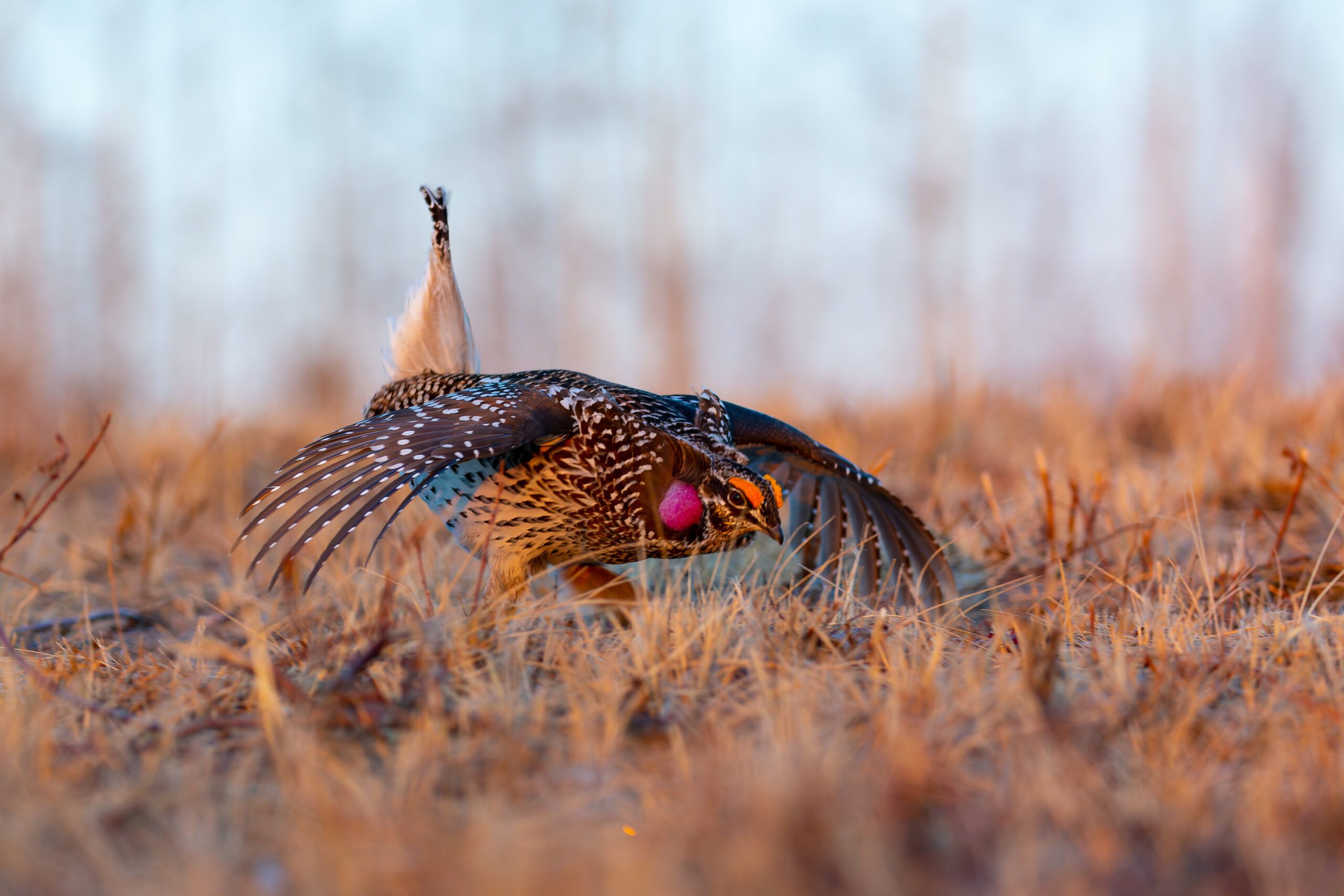Montana reintroduces the only bird missing from its western half.
By Benjamin Alva Polley EBS COLUMNIST

Dawn’s first light adorned the undulating prairies northwest of Choteau, Montana, as male sharp-tailed grouse fancy-danced across the lek. The lek is a traditional dance floor where males come to compete for the honor of breeding. But something was different in the leks this year: wire boxes, baited with berries and lined with guiding fences like funnels, lined the grass. The white and speckled brown colored males spread their wings, arched their tails, strutted, and stamped their little feet before curiosity guided them to ‘walk-in’ boxes while some hens followed. Teams sprinted to the traps from blinds with fishnets, mesh bags, and cardboard boxes. They captured both sexes of grouse for an ongoing reintroduction project in western Montana. It was late April.
Sharp-tails used to be one of the most abundant upland game birds in grassland hills, also known as sage-steppe in western Montana. But over the past 75 years, this vital member of the grassland community has steadily declined, and a hunting season for them ended in 1948. The birds went extinct in western Montana in the early 2000s. Sharp-tails are the only birds that existed when the Lewis & Clark expedition passed through that are no longer present in 25% of the state. Although biologists don’t fully understand the reasons for their disappearance, theories include habitat loss from fire suppression, conventional agriculture, overgrazing, construction of reservoirs—then the resulting loss of genetic diversity. Like many other species, sharp-tails need large tracts of contiguous habitat. While generalists adapt quickly to shrublands and intermittently treed areas, these grouse don’t like the evergreen encroachment that invites more predatory raptors and which both physically and genetically segregates their populations.
After three decades of planning and research, a diverse partnership of Montana Fish, Wildlife and Parks, Montana State University, private landowners, and sportsmen’s groups have continued their plan to bring sharp-tails back to western Montana. They’ll trap birds in the eastern part of the state, where large and genetically diverse populations still exist, and transfer them to private lands in two valleys identified with suitable habitat for successful reintroduction: the Bitterroot and the Blackfoot. Researchers identified three private landowners for initial release over the next nine years, but now in the third year, they have narrowed it down to two. They hope to establish two self-sustaining populations. This year, they caught grouse in live traps on Nature Conservancy land near Choteau, restored coal mining company land near Colstrip, and U.S. Bureau of Land Management land near Glasgow.
“FWP is the state wildlife management agency that regulates wildlife through protocols, assessments, and certain policy guidelines to give the green light to this kind of project,” said Ty Smucker, FWP wildlife biologist. “But it’s not just us. It’s about other partners stepping up, whether other professionals, funders, or volunteers. It’s amazing the number of folks who helped us this year.”
Sharp-tails are indicator species signaling the health of native shrub-grasslands. These birds consume a wide variety of insects, including drought-induced grasshoppers. Also, they consume a whole host of plants and berries, helping disperse those seeds to new locales. Grouse are also important food for many predators. These birds are a critical game species both historically and for modern hunters and birders, who come from all over the world to witness springtime courtship displays every fall.
Later that April morning outside Choteau, project volunteers netted the birds from under the traps, placed them in mesh bags, then set them down in cardboard boxes for transport to their camp. There, biologists gathered in a wall tent to weigh and measure the birds, check them for injuries and parasites, and take blood samples. They clipped a toenail to draw a single drop of blood to document their genetic profile. They banded each of their legs with numbers to identify them and fit each bird with one of the three different transmitters—nano-tag, VHF, or GPS—to help researchers locate them after release. Last, they placed the captured birds in boxes in an air-conditioned vehicle and drove them (although one day, a volunteer even piloted a Cessna) across the state to ranches, where other teams received the birds and again checked their vitals before placing them in release boxes.
In 2006, a genetic analysis concluded that the sharp-tails in western Montana were all historically Plains subspecies, not the much rarer Columbian. This discovery opened the possibility for a potential reintroduction effort. A group with a specific purpose moved forward analyzing and comparing habitat quality in the eastern part of the state with habitat in all of western Montana, initially identifying three potential valleys with terrain as good or better than environments supporting birds in eastern Montana. The group asked MSU researchers to author a restoration plan in 2017, and FWP prepared an environmental assessment which the FWP Commission authorized in 2019. It took the group another two years to gather the necessary funding and population data identifying large “source” leks to move the dream toward reality.
As a precaution, FWP canceled the grouse trapping season early last year after only 43 healthy birds had been moved when avian influenza was detected in the eastern part of the state. Still, two hens produced over 20 chicks in western Montana for the first time in almost 25 years. Now in the third year, the team captured 75 hens and 68 males, likely significantly boosting birds that survived the earlier smaller transplants.
“Sharp-tails are difficult to conserve. Montana’s lucky to still have large populations in eastern parts of the state,” said Ben Deeble, president of the Big Sky Upland Bird Association and lead proponent of the project. “They’re the only bird that historically bred in western Montana, now absent. I’ve dedicated myself to trying to bring back this last missing member of our bird community.”
Twenty-four hours later and hundreds of miles from the opening scene, project teams huddled in trucks in the dark, waiting for dawn’s first light. The only miles-distant light came from the Manley homeplace, a 20,000-acre cattle ranch in the upper Blackfoot Valley near Helmville, Montana. Coyotes yipped and howled. The team hid behind camouflaged-colored burlap cloth taped to the truck’s ceiling and gripped nylon cords strung to a sliding door on release boxes.
They pulled the cords individually, liberating the birds from the temporary grouse hostels. Every five minutes, another grouse sauntered out onto the lek. Some flushed immediately, while others cautiously stepped out, taking in sounds and views. A few immediately danced. Vocal songs of other-worldly sharp-tail cooing came from hidden speakers soothing them and helping them feel at home. The birds are dancing on their own lek this year; no decoys required. This project is an excellent example of private working ranches cooperating with conservation groups and agencies to restore and enrich biodiversity.
Only time will tell if sharp-tails will again dance the “steppe” for years to come on Montana’s western valley grasslands.
Benjamin Alva Polley is a place-based storyteller with stories published in Outside, Adventure Journal, Popular Science, Field & Stream, Esquire, Sierra, Audubon, Earth Island Journal, Modern Huntsman, and other publications at his website www.benjaminpolley.com/stories. He holds a master’s in Environmental Science and Natural Resource Journalism from the University of Montana.
















